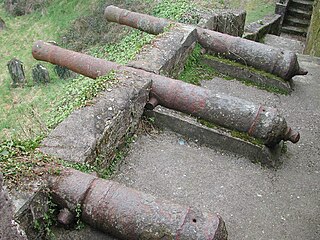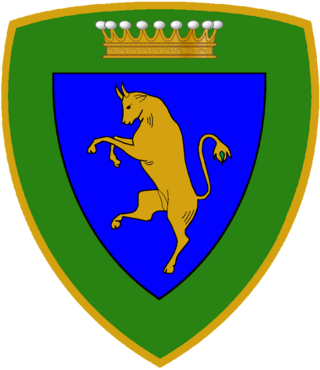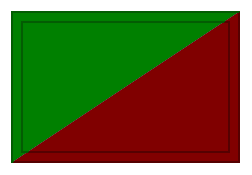
A battalion is a military unit, typically consisting of 300 to 1,000 soldiers commanded by a lieutenant colonel, and subdivided into a number of companies. The typical battalion is built from three operational companies, one weapons company and one HQ company. In some countries, battalions are exclusively infantry, while in others battalions are unit-level organisations.
A company is a military unit, typically consisting of 100–250 soldiers and usually commanded by a major or a captain. Most companies are formed of three to seven platoons, although the exact number may vary by country, unit type, and structure.

A regiment is a military unit. Its role and size varies markedly, depending on the country, service and/or a specialisation.

In military organizations, an artillery battery is a unit or multiple systems of artillery, mortar systems, rocket artillery, multiple rocket launchers, surface-to-surface missiles, ballistic missiles, cruise missiles, etc., so grouped to facilitate better battlefield communication and command and control, as well as to provide dispersion for its constituent gunnery crews and their systems. The term is also used in a naval context to describe groups of guns on warships.

The Royal Gibraltar Regiment is part of British Forces Gibraltar for the British overseas territory of Gibraltar, which historically, along with Bermuda, Halifax, Nova Scotia, and Malta, had been designated an Imperial fortress rather than a colony. It was formed in 1958 from the Gibraltar Defence Force as an infantry unit, with an integrated artillery troop. The regiment is included in the British Army as a defence engagement force. In 1999, the regiment was granted the Royal title. The regiment recruits from Gibraltar, the United Kingdom, Republic of Ireland and the Commonwealth.
The Royal Netherlands Army Artillery provides artillery support for the Royal Netherlands Army. It is divided into three corps, undertaking two roles: Korps Veldartillerie - Field Artillery and Korps Rijdende Artillerie - Horse Artillery. These two corps undertake the field artillery role. They are equipped primarily with the PzH2000 and were equipped with the M109 howitzer. Until 2013, one regiment retained the traditions of the Veldartillerie and one of the Rijdende Artillerie, with one assigned to each of the army's mechanised brigades.

The Land Component is the land branch of the Belgian Armed Forces. The King of the Belgians is the commander in chief. The current chief of staff of the Land Component is Major-General Pierre Gérard.
Abteilung is a German word that is often used for German or Swiss military formations and depending on its usage could mean detachment, department or battalion; it can also refer to a military division. In German, it is used both for military and civilian departments.

The 16th Regiment, Royal Australian Artillery is the Australian Army's only ground-based air defence (GBAD) unit. It also provides sense, warn and locate, ground liaison, and joint terminal attack control capabilities. Part of the Royal Regiment of Australian Artillery (RAA), the regiment is responsible for protecting a wide range of military assets during wartime, ranging from Army units in the field to providing point defence to the Royal Australian Navy's support ships and air defence to Royal Australian Air Force air bases. Prior to being equipped with the currently in-service RBS-70 surface-to-air missile system, the regiment was equipped with the Rapier systems for 25 years. The regiment is based at Woodside, South Australia, but frequently deploys with other Australian and allied units on operations and defence exercises. It is part of the 6th Brigade.
This is the Operation Herrick ground order of battle, which lists any British ground forces that have taken part in the duration of Operation Herrick between 2002 and 2014.

The Alpine Brigade "Julia" is a light infantry brigade of the Italian Army, specializing in mountain warfare. Its core units are Alpini, an infantry corps of the Italian Army, that distinguished itself during World War I and World War II. The brigade carries on the name and traditions of the 3rd Alpine Division "Julia". The division's and brigade's name allude to the Julian Alps in the Friuli region where the division's regiments recruited their troops, and where after World War II the brigade was based. Accordingly, the brigade's coat of arms is modeled after the Friuli region's coat of arms.

The Alpine Brigade "Taurinense" is a light Infantry brigade of the Italian Army, specializing in Mountain Combat. Its core units are Alpini, the mountain infantry corps of the Italian Army, that distinguished itself in combat during World War I and World War II. The brigade's name "Taurinense" alludes to the Roman name Augusta Taurinorum for the city of Turin around which the brigade is based. Accordingly the brigade's coat of arms is modeled after Turin's coat of arms. The brigade carries on the name and traditions of the 1st Alpine Division "Taurinense".

The 8th Canadian Infantry Division was a military formation of the Canadian Army that served within Pacific Command in Western Canada during World War II. The Division units were raised on 18 March 1942 and the HQ was raised on 12 May 1942 at Prince George, BC. The Division was a home defence unit, initially consisting of the 19th, 20th, and 21st Canadian Infantry Brigades. In July the home Defence Divisions were reorganised and the 8th Division consisted of the 14th and 16th Infantry Brigades. The 19th Brigade went to the 6th Canadian Infantry Division, the 20th went to the 7th Canadian Infantry Division, and the 21st would remain at Valcartier, PQ as a strategic reserve. The 8th Canadian Infantry Division was disbanded on 15 October 1943, along with the 16th Brigade. The 14th Brigade returned to the 6th Division.

Operation Undergo was an attack by the 3rd Canadian Infantry Division on the German garrison and fortifications of the French port of Calais, during September 1944. A subsidiary operation was executed to capture German long-range, heavy artillery at Cap Gris Nez, which threatened the sea approaches to Boulogne. The operation was part of the Clearing the Channel Coast undertaken by the First Canadian Army, following the victory of Operation Overlord and the break-out from Normandy. The assault on Calais used the tactics of Operation Wellhit at Boulogne, sealing the town, bombardments from land, sea and air, followed by infantry assaults supported by armour, including flame-throwing tanks and creeping barrages.

The Czech Land Forces are the land warfare force of the Czech Republic. The Land Forces consisting of various types of arms and services complemented by air and special operations forces constitute the core of the Czech Armed Forces. Land Forces Command is located in Olomouc.
Enhanced Forward Presence (EFP) is a NATO-allied forward-deployed defense and deterrence military force in Central and Northern Europe. This posture in Central Europe through Poland and Northern Europe through Estonia, Latvia, and Lithuania, is in place to protect and reassure the security of NATO's Central and Northern European member states on NATO's eastern flank.
The following is a hierarchical outline of the Czechoslovak People's Army at the end of the Cold War. It is intended to convey the connections and relationships between units and formations. At the end of the Cold War in 1989 the Czechoslovak People's Army structure was as follows.

The Artillery Battalion is the only artillery battalion in the Motorized Brigade of the Belgian Armed Forces.

The Joint Ground-based Air Defence Command is a joint command of the Royal Netherlands Army, formed in 2012 after amalgamation of the Commando Luchtdoelartillerie of the Royal Netherlands Army and the Groep Geleide Wapens of the Royal Netherlands Air Force. The command is responsible for all ground-based air defence tasks and consists of both army and air force personnel. The DGLC employs an integrated layered air-defence approach featuring FIM-92 Stinger, NASAMS II and MIM-104 Patriot systems.

The Fire Support Command is the artillery arm of the Royal Netherlands Army. The command consists of 41 Artillery Battalion, a staff, the Fire Support School and the artillery training grounds and is part of the Operational Support Command Land.














